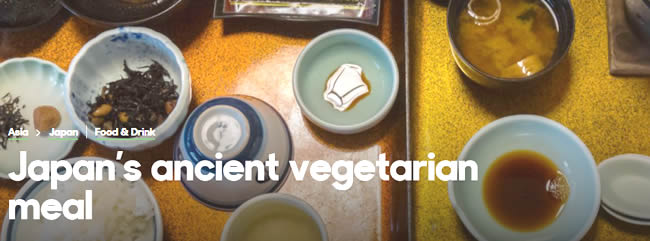昨日から「Japan’s ancient vegetarian meal -「日本古来の菜食料理」を読んでいます。

・「日本古来の菜食料理」(1)
Often called “devotion cuisine”, shōjin ryōri was developed by monks, but has recently found its way from temple restaurants to Tokyo’s Michelin-star tables.
精進料理は「勤行料理」と呼ばれることもあり、僧侶によって開発されたが、最近では寺院の食堂から東京のミシュランの星を獲得した店へと辿り着いた。
devotion「献身、一意専心、傾倒、愛情、熱愛、(時間・努力・金などを)傾けること、(宗教的な)帰依、信心、祈祷、勤行」。
Both minimal and plentiful, it is often associated with austerity;
必要最小限にして十分、それはしばしば苦行を連想させる
austerity「厳格、厳粛、簡素、質素(な生活)、禁欲、苦行、耐乏、緊縮経済」。
however, dedicated chefs profess a myriad of visual, technical and seasonal combinations are possible.
だが専任の調理人は、視覚的、技術的、季節的な組み合わせは無数にあると明言する。
profess「公言・明言する、~のふりをする、偽る、自称する、~を信仰する」。
myriad of~「無数の、数え切れないほどの」。
Arriving in Japan with Buddhism in the 6th Century, shōjin cuisine was traditionally a simple affair, preserved by hard-working priests and monks, explains Shiten, Ekoin’s resident priest.
6世紀に仏教と共に日本に伝わった精進料理は、熱心な僧侶らによって代々受け継がれた単純な物でした、と恵光院の住職、シテン氏は説明する。
It was the teachings of 13th-Century writer and Soto Zen school founder, Dogen, however, that pioneered the spiritual focus of the art.
だがそれが13世紀の作家で曹洞宗の開祖、道元の教えにより精神集中の術として開拓された。
Dogen believed that, similar to the practice of flower arranging or tea ceremony, shōjin ryōri had the power to align mind, body and soul.
道元は生け花や茶道と同じように、精進料理にも心と体と魂を集合させる力があると信じたのだ。
精進料理の別名 devotion cuisine が「勤行料理」かどうかは分かりません(調べても別名が出てきませんでした)。
精進料理の食材の下ごしらえ、調理はとても手間のかかる工程が多く、それ自体が僧侶の修業であるという考え方があるそうなので、恐らく「仏教修業の料理」といった意味だと思うんですが・・・。
なかなか家庭では真似出来ない(作るの大変そうで・笑)ですから、機会があれば本格的な精進料理を体験してみたいものです。
理由は単純明快!「少ないコストでしっかり楽しく学べるから」。
私自身の経験(高機能でビックリ)をびっしり書いていますので、良かったら読んでみてください。
下のバナーからどうぞ!






